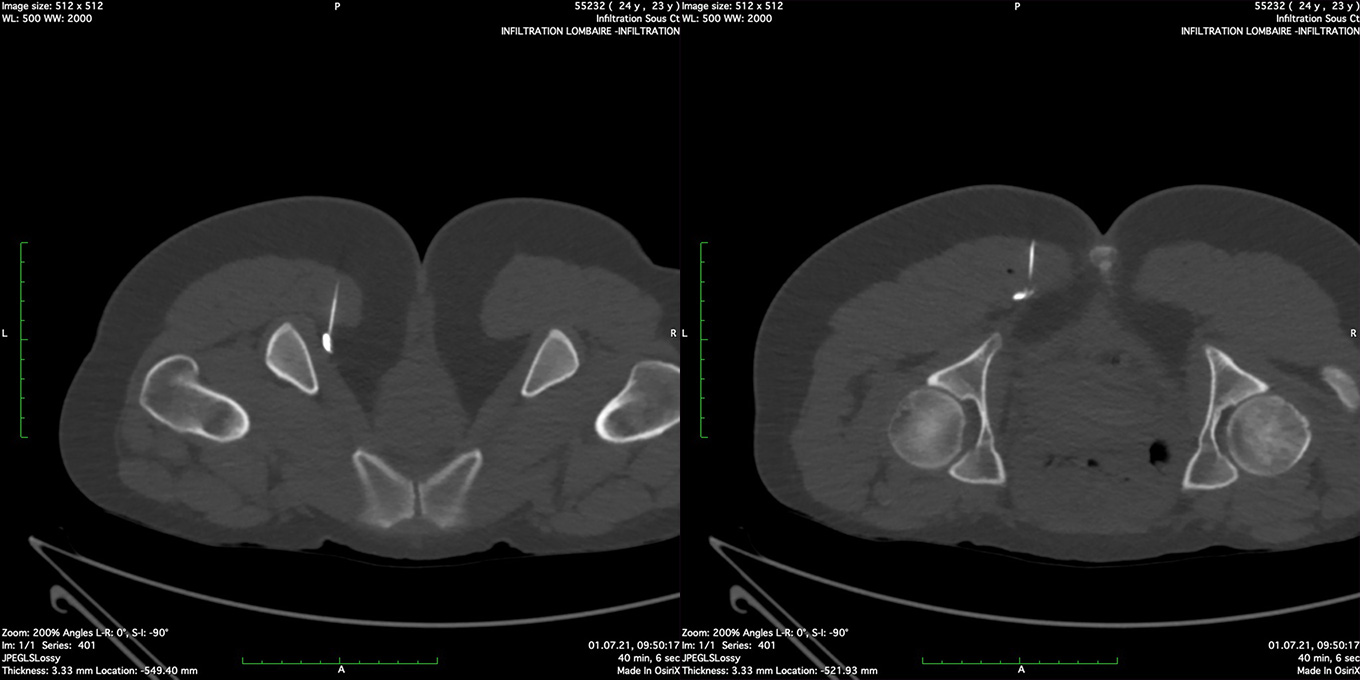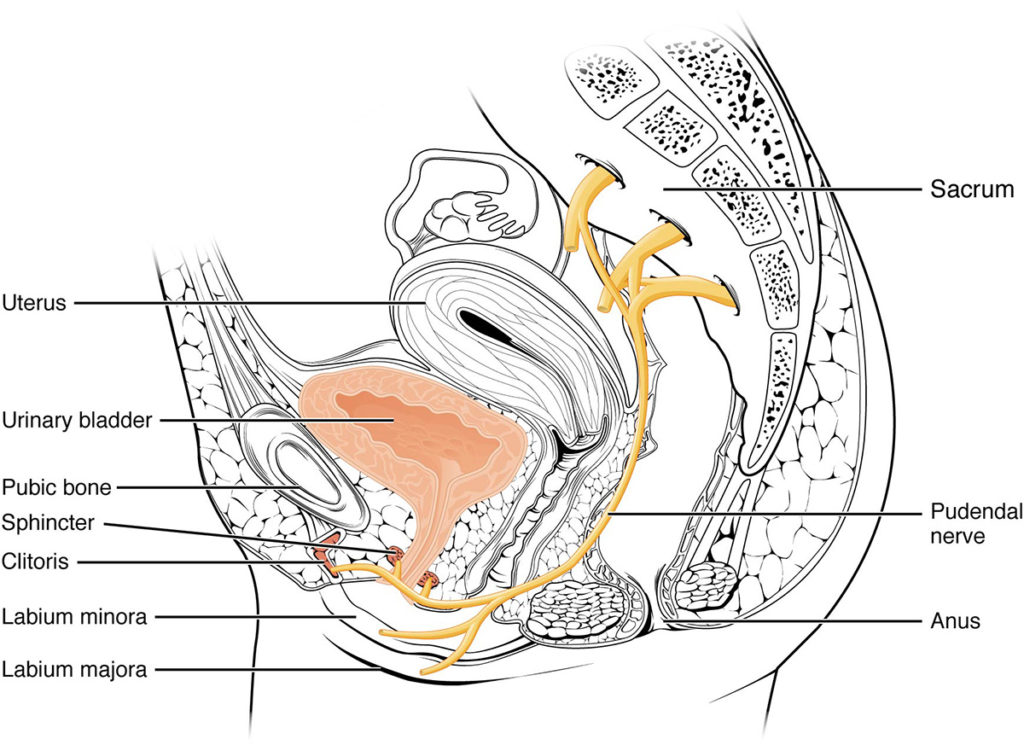
Pudendal infiltration under CT guidance
Alcock canal syndrome is manifested by pain in the pelvis. This is the lower part of the pelvis. Acute burning sensations, electric shocks, tightness or numbness are the main symptoms experienced by patients with this condition.
Also called pudendal neuralgia, this neurological pathology results in particular from the compression of the pudendal nerve in the perineum.
These compressions are located in the ischioanal fossa – the triangular space located laterally to the anal canal and under the pelvic diaphragm – or at the sacrospinous ligament which inserts into the lower part of the external border of the sacrum and the coccyx.
This syndrome can be caused by a tumour that presses on the nerve, an inflammatory disease or a mechanical compression that subjects the body to too much tension, such as during intensive cycling or a herniated disc. However, a hypertonic pelvic floor, a fall or fibrosis related to an old surgical scar (in particular the treatment of urinary incontinence by suburethral sling) can also cause compression of the pudendal nerve.

Diagnostic criteria for pudendal neuralgia
As this is a progressive condition, flare-ups can develop and it can suddenly worsen. The pain becomes permanent, daily and worsens when sitting.
Thus, the essential criteria for diagnosis, also called Nantes criteria, are:
- superficial or deeper pain in the pudendal nerve area, either at the anorectal level, at the vulvovaginal level unilaterally or bilaterally;
- worsened by sitting;
- the patient is not woken at night by the pain;
- no objective sensory loss;
- significant disappearance of pain during pudendal nerve anaesthesia.
The consequences of Alcock canal syndrome
When suffering from Alcock canal syndrome, even the simplest daily activities can cause acute pain due to the compression that the nerve undergoes. It becomes difficult for patients to sit down, to go to work, or to maintain an ordinary social life. The simplest activities to relieve the body can be difficult and require forward planning. Loneliness can in some cases lead to a feeling of unease. This is why its psychological impact is significant: intimacy and family, social and professional life is altered.
Being a pathology that is still little known, patients will often consult many doctors and follow many different therapy programs before this diagnosis is revealed. It may be several months or even years before we see these patients.
What is pudendal infiltration under CT guidance?
Although it is a second-line treatment, pudendal infiltration when used according to a very precise protocol, can confirm the diagnosis as well as improve the condition and quality of life of the person who is suffering.
More precisely, performing a test infiltration, followed by therapy on the pudendal nerve under CT guidance, can prove useful in confirming the diagnosis and significantly reducing or even eliminating the pain.
The effectiveness of this method can be seen in the days following administration of the treatment.
The pudendal infiltration process
This is a procedure performed unilaterally or bilaterally under CT guidance on the affected areas.
During the procedure, you will be lying on your stomach and under the CT scanner for the duration of the session. The radiologist, assisted by a medical imaging technician, will successively introduce between two to four needles in order to locally inject a test anaesthetic, followed by a corticosteroid-based anti-inflammatory. These needles are extremely thin and cause only temporary discomfort.
In general, the procedure only lasts approximately twenty minutes. After a short observation period, you can return home. However, be careful not to strain the affected area for a few days.
What are the advantages of infiltration?
In a significant percentage of cases, a clear improvement in symptoms is observed, whether permanent or prolonged, due to a reduction or even elimination of deep pelvic, perineal and buttock pain.
The score improves with the second or third injection. This procedure can be repeated several times, i.e. 2 or 3 times, at an interval of approximately one month.
Are there any risks and/or complications linked to a pudendal infiltration?
Due to the precision of the procedure performed and the expertise of our radiologists, complications remain extremely rare.
Want to learn more about pudendal infiltration?
If you would like more information on pudendal infiltration or would like to make an appointment for an examination, do not hesitate to contact us.
Want to learn more about the different infiltration techniques?
At the Medimage centre in Geneva, we have developed infiltration procedures and techniques that work and effectively relieve patients of their pain.
We will be happy to take care of you and discuss this syndrome with you.
But also…
Learn more about facet joint infiltrations, extra-articular infiltration, osteoarticular infiltration, foraminal spinal infiltration, epidural lumbar infiltration or hyaluronic acid infiltrations.
Learn more about the other examinations available at the Medimage centre: radiography and radiology in Geneva, MRI in Geneva (Magnetic Resonance Imaging), CT scan, cardiac imaging, mammogram in Geneva, ultrasound in Geneva, elastography, biopsy in Geneva, infiltrations in Geneva, PRP infiltrations, dental panoramic or mineralometry.
Take a look at our medical team and our radiologists.
